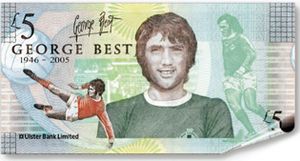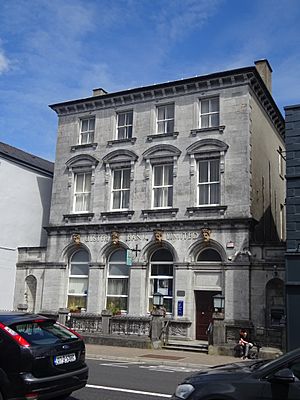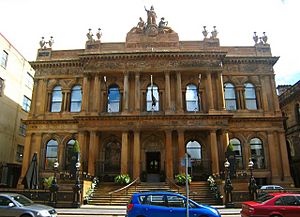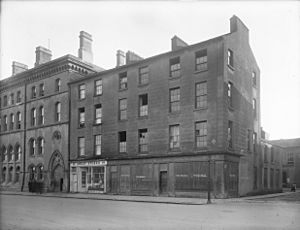Ulster Bank facts for kids
|
Trade name
|
Ulster Bank |
|---|---|
| Private | |
| Industry | Financial services |
| Founded | 22 February 1836 Belfast, Northern Ireland, United Kingdom, as the Ulster Banking Company |
| Headquarters | Belfast, Northern Ireland, United Kingdom |
|
Key people
|
Jane Howard |
| Products | Various banking products |
|
Number of employees
|
3,250 (2013) |
| Parent | NatWest Holdings |
Ulster Bank is a well-known bank that has served people in Ireland for a long time. It was one of the main banks in Ireland. The bank used to have two main parts. One part operated in Northern Ireland and the other in the Republic of Ireland.
Ulster Bank started in Belfast in 1836. Later, a bigger bank called London County and Westminster Bank bought it in 1917. Eventually, it became part of the NatWest Group in 2000. Even though it's part of a larger group, it still uses the Ulster Bank name in Ireland.
Ulster Bank had many branches and ATMs across Ireland. It also had thousands of employees helping over a million customers. In 2021, NatWest Group decided to close Ulster Bank's operations in the Republic of Ireland. This process finished in April 2023. Ulster Bank continues to operate in Northern Ireland.
Contents
History of Ulster Bank
How Ulster Bank Started
Ulster Bank began as The Ulster Banking Company in Belfast in 1836. It was started by a group of people who used to be part of another bank. They wanted to invest the bank's money in Belfast, not in London.
The first directors of the bank included John Heron and Robert Grimshaw. John Currell, a linen bleacher, and James Steen, a pork curer, were also founding directors.
Ulster Bank opened its first office on Waring Street, Belfast, on July 1, 1836. Right away, it started printing its own banknotes. Within a year, it opened many new branches in towns like Armagh and Enniskillen. Over the next 20 years, it opened 11 more branches across Ulster.
In 1860, Ulster Bank opened a new main office in Belfast. It also opened branches in Sligo and Ardee. By 1862, it had an office in Dublin. The bank continued to grow, opening 24 more branches over the next 12 years. In 1883, it became a limited company called Ulster Bank Ltd. It also opened more branches in Dublin and moved to a new building there in 1891.
Ulster Bank in the 20th Century
In the early 1900s, Ulster Bank opened branches in more cities like Wexford and Cork. In 1917, a larger bank, the London County and Westminster Bank, bought Ulster Bank. However, Ulster Bank kept its own name and identity.
During the 1960s, Ulster Bank opened branches in the suburbs of Belfast and Dublin. It also started putting ATMs in its branches. ATMs are machines where you can get cash.
In 1968, Ulster Bank decided to manage its lending in the Republic of Ireland from Dublin. Its parent bank, Westminster Bank, joined with another bank to form National Westminster Bank.
In the 1970s, Ulster Bank started using mobile banks in some country areas. These were like banks on wheels. It also moved its main office in Belfast to Donegall Place. In 1975, Ulster Bank bought parts of other finance companies. It also started using the slogan "the friendly bank."
In 1980, Ulster Bank introduced the "Henri Hippo" money box. This was a fun way for schoolchildren to save money. In 1989, it launched its own Visa credit card.
Throughout the 1990s, Ulster Bank put ATMs in more places, not just in its branches. By 1995, it had the largest network of ATMs in Ireland. It also introduced the Switch debit card. In 1997, it opened its new main offices in Dublin.
Ulster Bank in the 21st Century
In 2000, Ulster Bank opened a new office in Belfast. Its parent company, National Westminster Bank, was bought by the Royal Bank of Scotland Group. In 2001, Ulster Bank's business in the Republic of Ireland became a separate company.
In 2002, a security issue happened at one of the bank's cash centers. Some employees were found to have taken old banknotes that were supposed to be destroyed. The bank later improved its security measures.
In 2003, Ulster Bank Group bought First Active, which was Ireland's oldest building society. A building society is like a bank that helps people save money and get loans for homes. First Active kept its name for a while. In 2005, Ulster Bank changed its logo to match the "daisy wheel" logo of the Royal Bank of Scotland. By 2010, First Active's branches became part of Ulster Bank.
In June 2012, a big computer problem stopped customers from using their accounts. This problem affected many customers for several weeks. Ulster Bank set aside money to pay back customers who were affected.
In 2015, the Central Bank of Ireland looked into how banks sold certain home loans called tracker mortgages. They found that Ulster Bank and other banks had not given some customers the correct rates. Ulster Bank was later fined for this issue in 2021. About 5,940 customers were affected.
In September 2020, it was reported that NatWest Group was thinking about closing Ulster Bank in the Republic of Ireland. This plan was confirmed in February 2021. Ulster Bank stopped its operations in the Republic of Ireland on April 21, 2023. Many of its branches were taken over by another bank, Permanent TSB.
In May 2022, Ulster Bank announced it would close nine branches in Northern Ireland. In November 2023, it announced the closure of 10 more branches in Northern Ireland in 2024.
Bank Services
Ulster Bank offers many different services. These include banking and insurance for individuals, businesses, and larger companies.
In Northern Ireland, Ulster Bank is part of National Westminster Bank. It is watched over by important groups like the Prudential Regulation Authority and the Financial Conduct Authority. These groups make sure banks are safe and fair. In the Republic of Ireland, the Central Bank of Ireland regulated the bank.
The bank gives customers a Debit Mastercard to use with their accounts. It also offers other financial services. In 2010, it made 15 new promises to its customers.
Bank Identity
For many years, Ulster Bank did not have a modern logo. It just used its name or its coat of arms. In the mid-1960s, it started to create a logo. This included a large "UB" design.
Around 1969, Ulster Bank started using the logo of its new parent company, National Westminster Bank. This logo had three arrowheads.
In 2005, Ulster Bank changed its logo again. It started using the "daisy wheel" logo of the Royal Bank of Scotland. It also changed the style of its writing.
Ulster Bank is one of three banks in Northern Ireland that can print its own pound sterling banknotes.
Banknotes Issued

Ulster Bank has the right to print its own banknotes in Northern Ireland. These notes are in pound sterling and have the same value as notes from the Bank of England. They are different from the old Irish pound notes, which were used in the Republic of Ireland before the euro.
Ulster Bank's current banknotes all have a similar design. They show a view of Belfast Harbour and landscapes. The back of the notes shows the bank's coat of arms. The notes come in different colors and sizes for different values. They also have a special security feature with the bank's logo.
- 5 pound note, grey
- 10 pound note, blue-green
- 20 pound note, purple
- 50 pound note, blue
In November 2006, Ulster Bank printed a special £5 note. This note honored George Best, a famous football player from Northern Ireland. One million of these notes were printed. Collectors bought them all very quickly. This was the first Ulster Bank note to use the RBS "daisy wheel" logo.
In 2019, Ulster Bank started printing new banknotes made of polymer. These plastic notes are more durable and replaced the older paper ones.
Sponsorships
Ulster Bank has supported many events and organizations.
In 2008, Ulster Bank announced it would sponsor the Belfast Festival at Queen's. This was a big deal for the festival, helping it with funding.
Ulster Bank was also the first main sponsor of The Balmoral Show in 2009. This is Northern Ireland's largest farming show.
In April 2008, Ulster Bank also became an official sponsor of the GAA All-Ireland Senior Football Championship. This is a major sports event in Ireland.
Images for kids







